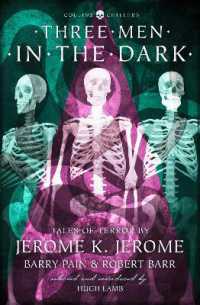- ホーム
- > 洋書
- > 英文書
- > Business / Economics
Full Description
Recent economic and financial crises have exposed mainstream economics to severe criticism, bringing present research and teaching styles into question. Building on a solid and vivid tradition of economic thought, this book challenges conventional thinking in the field of economics. The authors turn to the work of Luigi Pasinetti, who proposed a list of nine methodological and theoretical ideas that characterize the Classical Keynesian School. Drawing inspiration from both Keynes and Sraffa, this school has forged a long-standing and ambitious research programme often advocated as a competing paradigm to mainstream economics. Overall, the Classical Keynesian School provides a comprehensive analytical framework into which most non-mainstream schools of thought can be integrated. In this collection, a group of leading scholars critically assess the nine main ideas that, in Pasinetti's view, characterize the Classical-Keynesian approach, evaluating their relevance for both the history of economics and for present economic research.
Contents
Foreword Mauro Baranzini, Alberto Quadrio Curzio and Roberto Scazzieri; Introduction Enrico Bellino, Sebastiano Nerozzi; 1. Reality (and not simply Abstract Rationality) as the Starting Point of Economic Theory Maria Cristina Marcuzzo; 2. Economic Logic with Internal Consistency (and not only Formal Rigor): Beyond Formal Rigour: Realism and Internal Consistency in Piero Sraffa Neri Salvadori, Rodolfo Signorino; 3. Malthus and the Classics (not Walras and the Marginalists) as the Major Inspiring Source in the History of Economic Thought: The Principle of Effective Demand and Classical Economics Heinz D. Kurz; 4. Non-ergodic (in Place of Stationary, Timeless) Economic Systems: Considerations Suggested by Joan Robinson's Distinction between Two 'Notions' of Time in Economic Theory Ariel Dvoskin, Paolo Trabucchi; 5. Causality vs. Interdependence: A Distinction that Conveys a World's View Enrico Bellino, Sebastiano Nerozzi; 6. Macroeconomics before Microeconomics: A Sceptic's Guide to Macroeconomics Murray Milgate, John Eatwell; 7. Disequilibrium: Disequilibrium and Instability (Not Equilibrium) as the Normal State of the Industrial Economies: A Methodological Standpoint on Structural Economic Dynamics Ariel Luis Wirkierman; 8. Necessity of Finding an Appropriate Analytical Framework for Dealing with Technical Change and Economic Growth: Technical Change, Structural Dynamics and Employment Harald Hagemann; 9. A Strong, Deeply Felt, Social Concern Claudia Rotondi; Afterword: Why the Classic-Keynesian Trend May Be of Interest to a Young Scholar Today? Nadia Garbellini; Concluding Remarks: Pasinetti's Separation Theorem Bertram Schefold; Author Index; Subject Index.







